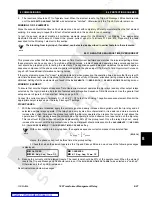
GE Multilin
745 Transformer Management Relay
8-35
8 COMMISSIONING
8.5 PROTECTION SCHEMES
8
3.
Slowly increase the amplitude of the 5th harmonic component until the element operates. Calculate the ratio of 5th har-
monic to fundamental at which operation occurred and compare this value to the setting of the element.
4.
Check that the Trip, Pickup (and if selected, Alarm) LEDs are on, and one of the following is displayed:
5.
Reduce the 5th harmonic component until the element resets. The reset level should be 97% of the operate level.
Reset indicators and clear messages.
6.
Repeat the above steps with a fundamental current level below the threshold setting. Ensure that the element does not
operate.
7.
For timing tests, simulate an operating condition as above and apply suddenly to the relay and measure the operating
time. The time should be the same as the setting in the element.
8.5.15 INSULATION AGING
The three elements under the Insulation Aging feature,
Hottest-Spot Limit
,
Aging Factor Limit
, and
Loss of Life Limit
, must
be tested with a valid set of transformer data programmed into the relay. The ambient temperature must also be pro-
grammed (obtained from an RTD or programmed as 12-month averages). The tests consist of simulating transformer load-
ing by applying a current signal to Winding 1 Phase A at the correct frequency.
a) HOTTEST-SPOT LIMIT
The hottest-spot temperature value is a function of load, ambient temperature, and transformer rating. Apply a current to
Winding 1 Phase A to represent at least a 100% load on the transformer. Use the
A2 METERING
ÖØ
LOSS OF LIFE
Ö
HOT-
TEST-SPOT WINDING TEMPERATURE
actual value to observe the hottest spot temperature increases gradually. The simulated
load to may be increased for a faster temperature rise.
When the hottest spot temperature reaches the
S4 ELEMENTS
ÖØ
INSULATION AGING
Ö
HOTTEST-SPOT LIMIT
ÖØ
HOTTEST-
SPOT LIMIT PICKUP
operating level, the element should operate. Verify all programmed relay operations as per FlexLogic™
settings. Verify that all the targets and messages are as expected and programmed.
The time delay can be verified with a watch as the delay is normally set in minutes.
b) AGING FACTOR LIMIT
The Aging Factor value is also a function of load, ambient temperature, and transformer ratings. Apply a current to Winding
1 Phase A to represent at least a 100% transformer load. Use the
A2 METERING
ÖØ
LOSS OF LIFE
ÖØ
INSULATION AGING
FACTOR
actual value to observe that the aging factor increases gradually. You may want to increase the simulated load or
the simulated or programmed ambient temperature to cause a faster increase.
When the aging factor reaches the
S4 ELEMENTS
ÖØ
INSULATION AGING
ÖØ
AGING FACTOR LIMIT
ÖØ
AGING FACTOR LIMIT
PICKUP
operating level, the element should operate. Verify all programmed relay operations as per FlexLogic™ settings.
Verify that all the targets and messages are as expected and programmed.
The time delay can be verified with a watch as the delay is normally set in minutes.
c) LOSS OF LIFE LIMIT
Typical settings for the Loss-of-Life Limit element dictate that either the limit be changed or the initial transformer loss-of-life
be changed temporarily. Verification of this function is recommended by programming an initial loss-of-life above the ele-
ment threshold. The element operates instantly as it has no associated time delay.
8.5.16 TAP MONITOR FAILURE
The tap monitor failure element operates when the sensed resistance is 150% larger than the programmed values for the
monitor circuit. Connect a resistance to simulate the tap changer resistance and increase this resistance until the element
operates. Calculate that the resistance at which the element operated is 150% of the resistance that would be present at
the maximum tap position.
Verify all relay, targets and messages for correct operation per programmed values.
LATCHED
5th Harmonic Level
OPERATED
5th Harmonic Level
Содержание TRANSFORMER MANAGEMENT RELAY 745
Страница 2: ...Courtesy of NationalSwitchgear com ...










































